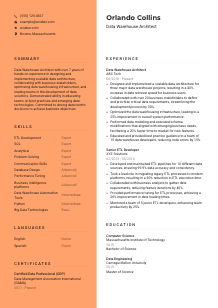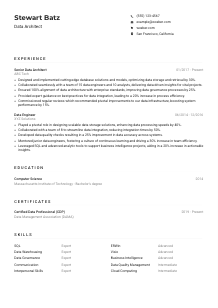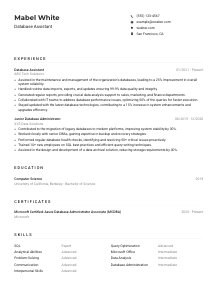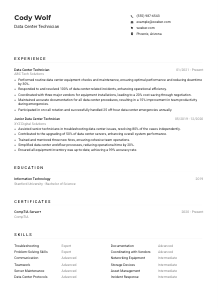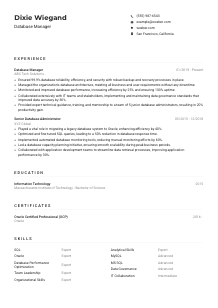Data Warehouse Architect Resume Example
Constructing data strongholds, but your resume feels stranded? Dive into this Data Warehouse Architect resume example, formulated with Wozber free resume builder. Discover how you can blueprint your data expertise to align with job requirements, creating a career narrative as robust and interconnected as the databases you design!
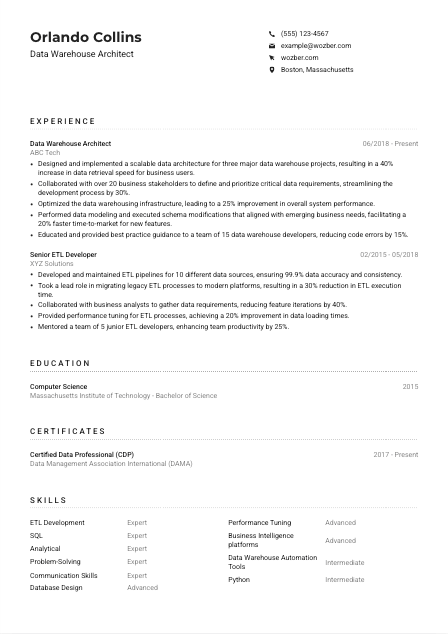
How to write a Data Warehouse Architect Resume?
Hey there, future Data Warehouse Architect champion! Are you ready to elevate your resume from just another document to a laser-focused, job-winning asset? In the highly competitive Data Warehouse Architect job market, standing out is not an option - it's a necessity. With Wozber's free resume builder, crafting an ATS-compliant resume tailored precisely to your dream job's requirements just got easier.
Let's dive into how you can create a resume narrative as powerful and efficient as the data architectures you're passionate about. Together, we can ensure your resume not only passes the ATS scan but also lands you in the interview chair.
Personal Details
First impressions are everything, especially on your resume. Your Personal Details section is the handshake before the conversation, setting the tone for what follows. Let's ensure yours says, 'I'm the perfect Data Warehouse Architect for this role.'
1. Your Name as Your Brand
Think of your name as the bold headline of your professional story. Use a clear, legible font to make it pop. Positioning it distinctly sets the stage for everything that follows on your resume.
2. Job Title Precision
Immediately below your name, match your job title to the one you're applying for - in this case, 'Data Warehouse Architect.' This simple act aligns your professional identity with the job at hand, signaling a perfect fit right from the start.
3. The Essentials: Contact Information
Your phone number and email address are your lifelines to potential employers. Ensure they're correct and professional. For emails, a combination of your first and last name always works best.
4. Location Matters
By including 'Boston, Massachusetts' prominently, you're ticking another box of the job's requirements, assuring the employer of your availability and suitability based on location without needing to delve deeper into the document.
5. Online Professional Presence
Including a LinkedIn profile can bolster your credentials, offering a deeper dive into your professional world. Just make sure it's as polished and pruned as your resume, providing a cohesive narrative across platforms.
Takeaway
Your Personal Details section is more than just functional; it's the opening act of your professional prowess. Keep it aligned, concise, and professional. It's the foundation upon which your narrative will be built, so make it sturdy and reflective of the role you're aiming for.





Experience
The Experience section is where you prove you're not just capable but extraordinary. Let's carefully craft this section to demonstrate your journey as a Data Warehouse Architect, spotlighting your prowess and alignment with the role's requirements.
- Designed and implemented a scalable data architecture for three major data warehouse projects, resulting in a 40% increase in data retrieval speed for business users.
- Collaborated with over 20 business stakeholders to define and prioritize critical data requirements, streamlining the development process by 30%.
- Optimized the data warehousing infrastructure, leading to a 25% improvement in overall system performance.
- Performed data modeling and executed schema modifications that aligned with emerging business needs, facilitating a 20% faster time‑to‑market for new features.
- Educated and provided best practice guidance to a team of 15 data warehouse developers, reducing code errors by 15%.
- Developed and maintained ETL pipelines for 10 different data sources, ensuring 99.9% data accuracy and consistency.
- Took a lead role in migrating legacy ETL processes to modern platforms, resulting in a 30% reduction in ETL execution time.
- Collaborated with business analysts to gather data requirements, reducing feature iterations by 40%.
- Provided performance tuning for ETL processes, achieving a 20% improvement in data loading times.
- Mentored a team of 5 junior ETL developers, enhancing team productivity by 25%.
1. Dissecting the Job's DNA
Firstly, parse the job requirements meticulously. For a Data Warehouse Architect, that might include specific projects, technologies, or achievements. Highlight the keywords and phrases that stand out - they're your map to tailoring your past roles.
2. Presenting Your Professional Story
Begin with your most recent role, ensuring each listed position includes your job title, employer, dates of employment, and, crucially, bullet points that hit the keywords and core competencies found in the job description.
3. Your Achievements Front and Center
When listing accomplishments, think impact and relevance. Did you increase data retrieval speed? How about optimizing data warehouse infrastructure? Quantify these achievements to give them weight. Show the tangible benefits your work brought to the business.
4. Quantify, Quantify, Quantify!
Numbers draw the eye and lend credibility to your claims. A '30% reduction in ETL execution time' is far more compelling than 'reduced ETL execution time.' Be specific, and wherever possible, quantify your achievements.
5. Relevance is Key
Not all accomplishments need to make the cut. Focus on those that mirror the job posting. This strategic approach not only keeps your resume concise but also paints you as the perfect candidate.
Takeaway
Your Experience section is the cornerstone of your resume. It's here that you prove your worth and affirm your candidacy. By aligning your past roles and achievements with the job description, you're essentially showing the hiring manager why you're the best fit. Approach this task with the precision and intelligence of a Data Warehouse Architect shaping data architecture.
Education
In the realm of Data Warehouse Architect roles, your educational background is the bedrock of your expertise. Let's sculpt this section to reflect the solid foundation upon which your skills and experience are built.
1. Identifying the Keystone
It all starts with understanding the job's educational requirements. For a Data Warehouse Architect, a 'Bachelor's degree in Computer Science, Information Systems, or a related field' is typically the keystone. Ensure your degrees align with this specification.
2. Structure with Clarity
Keep your Education section clean and readable. List your degrees in reverse chronological order, including the field of study, degree attained, institution, and graduation year.
3. Tailoring Degree Titles
If you have a degree in Computer Science or Data Engineering, spotlight it. For the Data Warehouse Architect role, these degrees resonate strongly with the job's requirements, cementing your suitability.
4. Relevant Courses and Projects
If early in your career or if you've taken courses significantly relevant to the Data Warehouse Architect role, list them. This demonstrates your dedication and direct preparation for the responsibilities of the position.
5. Additional Academic Honors
Should you possess relevant academic honors or have undertaken significant projects or thesis work tied to data warehousing, mentioning these can underscore your expertise and interest in the field.
Takeaway
Your educational background does more than tick a box; it's proof of your foundational knowledge and your journey into the world of data architectures. Make sure it aligns with the job's requirements, and let it highlight your readiness and fit for the role.
Certificates
In the fast-evolving field of Data Warehouse Architecture, certifications can be a powerful testament to your dedication and expertise. Let's strategically position your certifications to shine brightly on your resume.
1. Sifting Through the Job Specs
Even when the job posting doesn't explicitly require certifications, having them can set you apart. Identify any certifications that closely relate to the responsibilities or technologies mentioned in the job description.
2. Strategic Selection
Focus on certifications that directly relate to the role of a Data Warehouse Architect. Whether it's about mastering specific data modeling techniques or advanced ETL processes, choose those that resonate most with the job's requirements.
3. Dates Matter
Include the acquisition or expiration dates of your certifications, especially for ones in technologies that rapidly evolve. This demonstrates your commitment to staying current in your field.
4. Continuous Improvement
Stay ahead of the curve by regularly updating your certifications and pursuing new ones relevant to your career aspirations. This shows prospective employers your continuous commitment to professional development.
Takeaway
Certificates on your resume are more than just educational accolades; they're proof of your commitment to excellence and lifelong learning in the Data Warehouse Architect field. Highlight them wisely, and let them speak volumes about your expertise and dedication.
Skills
The Skills section is your chance to display your professional toolkit in a concise, impactful manner. For a Data Warehouse Architect, this section is critical, providing a quick snapshot of your expertise relevant to the role's intricacies.
1. Deciphering Job Requirements
Begin with the job posting, extracting both the explicit and implied skills needed for a Data Warehouse Architect. Skills like 'ETL Development', 'SQL', 'Database Design', and 'Performance Tuning' are likely to feature prominently.
2. Matching and Showcasing
Line up your skills with those mentioned in the job description. Prioritize hard skills specific to the role, such as 'Data Modeling' and 'Business Intelligence platforms', but don't forget to include relevant soft skills like 'Analytical' and 'Problem-Solving'.
3. Organization is Key
You might have a broad range of skills, but clutter can overshadow impact. Organize your skills from most to least pertinent to the job. This helps the hiring manager quickly see your fit for the role.
Takeaway
Your skills section should act as a beacon, drawing the hiring manager's eye to your core competencies. This part of your resume isn't just a list; it's a strategically crafted showcase of your proficiency as a Data Warehouse Architect. Focus on relevance and clarity, positioning yourself as the standout candidate.
Languages
In the diverse and interconnected world of Data Warehouse Architecture, your ability to communicate in multiple languages can be a significant advantage. Let's navigate through the Languages section to best present your linguistic skills.
1. Job Requirements and Language Needs
Initially, assess if the job posting calls for specific language skills. 'Ability to operate in an English-speaking work environment' was a requirement for this role, making English proficiency pivotal to mention first.
2. Prioritizing Languages
List languages in order of relevance to the job. If English is a must, it takes top billing. Subsequent languages are listed by proficiency level and relevance to potential business needs.
3. Other Languages as Assets
If you speak additional languages, include them even if they aren't specified in the job posting. It showcases your versatility and potential to collaborate in a multicultural work environment.
4. Clear Proficiency Levels
Be transparent about your proficiency in each language using clear descriptors like 'Native', 'Fluent', 'Intermediate', and 'Basic'. This clarity is important for setting accurate expectations.
5. Considering the Role's Scope
Even if a Data Warehouse Architect role doesn't emphasize language skills, being multilingual can be advantageous, especially in roles with global reach or dealing with international stakeholders.
Takeaway
Showcasing your language skills is about more than just lists; it's about highlighting your ability to navigate and thrive in a global professional landscape. Keep your language section precise and honest, demonstrating yet another facet of your remarkable skill set as a Data Warehouse Architect.
Summary
Your summary is where you set the tone, providing a crisp introduction to your professional self. For a Data Warehouse Architect, this section must encapsulate your expertise, skills, and unique contributions in a few impactful sentences.
1. Capturing the Role's Essence
Begin by absorbing the job requirements, identifying key skills and experiences that define a Data Warehouse Architect. This understanding will guide you in developing a summary that speaks directly to what employers are seeking.
2. A Professional Snapshot
Start your summary with a brief introduction to your professional identity. 'Data Warehouse Architect with over 7 years of hands-on experience in designing and implementing scalable data architectures' immediately signals your fit for the role.
3. Showcasing Your Value
Incorporate your key skills and notable achievements next. Highlight your expertise in areas like ETL development, SQL, and business intelligence platforms, as well as your ability to lead and innovate. This showcases not just capability, but impact.
4. Brevity is the Soul of Wit
While there's much you might want to say, remember the power of concise communication. A few well-chosen lines can be more effective than overloading this section with information that might be better placed elsewhere in the resume.
Takeaway
Your resume's summary is your elevator pitch - an opportunity to capture the hiring manager's interest and persuade them that they're looking at the resume of the Data Warehouse Architect they need. Make every word count, clearly demonstrating your fit and fervor for the role right from the start.
Embark on Your Data Warehouse Architect Adventure
Congratulations, you're now equipped with a blueprint for crafting a targeted, compelling Data Warehouse Architect resume. Your resume is the key to unlocking new career opportunities. By using Wozber's free resume builder, you embrace an ATS-compliant structure that's ready for ATS optimization with our ATS resume scanner. This tailored approach ensures your resume not only matches the job description but also stands out for its clarity, relevance, and professionalism.
Your journey to becoming a Data Warehouse Architect is well on its way. Let your resume be the bridge that leads you to your next great adventure. Good luck!

- Bachelor's degree in Computer Science, Information Systems, or a related field.
- Minimum of 5 years of experience in data warehousing, dimensional modeling, and ETL development.
- Expertise in SQL, database design, and performance tuning for data warehouses.
- Proficiency with data warehouse automation tools and Business Intelligence platforms such as Tableau or Power BI.
- Strong analytical, problem-solving, and communication skills.
- Ability to operate in an English-speaking work environment.
- Must be located in Boston, Massachusetts.
- Design and implement scalable data architecture for data warehouse solutions.
- Collaborate with business stakeholders to define and prioritize data requirements.
- Optimize data warehousing infrastructure and processes to improve performance and reliability.
- Perform data modeling and schema modifications based on business needs.
- Educate and provide guidance to the data warehouse development team on best practices and emerging technologies.







